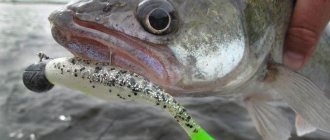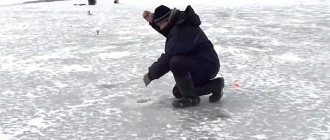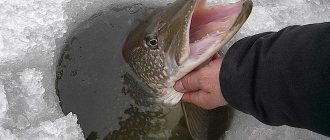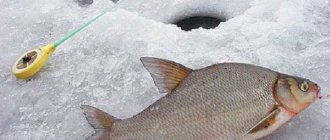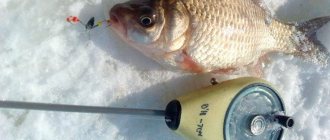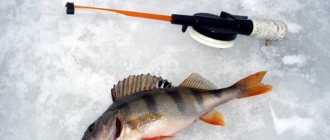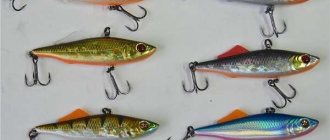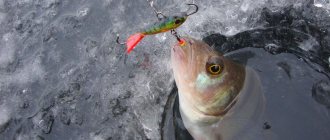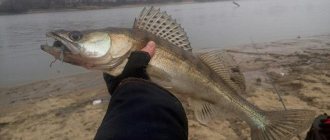Most often, fans of winter fishing catch small fish, roach or bream, perch or chub. But even in winter you can come across qualifying trophies, and in particular, catching pike perch on a balancer pleases with efficiency and large specimens.
Even purposeful fishing for pike with baits or girders will not always produce a large predator, but the use of bait in the form of artificial fish when fishing for pike perch is considered one of the most effective ways of catching trophy fish.
Along with pike perch, its relative, bersh, is also caught on balancer hooks, and some fishermen do not distinguish these predators from each other. The appearance of pike perch and bersh is very similar. But bersh is much more modest in size, while pike perch is considered the largest representative of the perch family inhabiting the waters of our country.
The weight of pike perch in adulthood reaches 15 kg, while bersh grows up to one and a half kilograms, although such a trophy is desirable for winter fishing. To distinguish these fish from each other, it is enough to look at the gills and cheeks; while in pike perch they are without scales, in bersha they are covered with small scales.
Bersh and pike perch coexist well in lakes and rivers, but bersh move in schools, while trophy pike perch prefers “single” swimming. The bites of the bersh are timid, biting, while the pike perch greedily grabs the bait and is caught by one of the hooks.
Like other predatory fish, both pike perch and bersh are caught with live bait, as well as with spoons and balancers. The last bait is rightfully considered the most catchy for pike perch, and it is used with pleasure by fans of winter fishing. They also catch pike perch on balance beams in the summer from a boat, and they help achieve good results.
A balancer is an artificial bait made in the shape of a small fish, and equipped with hooks in the front and back, as well as a tee at the bottom. The position of the bait is vertical and when the angler performs a retrieve, it seems to balance in the water column. The correct position of the balancer in the water is an important point, because it should look natural and attractive to a predator.
What you need to successfully catch pike perch using balance beams
In order for winter fishing for pike perch on a balancer to give the desired result, several conditions need to coincide and these are:
- correct choice of place on the pond;
- use of fishing gear;
- attractive baits;
- correctly chosen tactics;
- an effective “game” with a balancer, attracting fish and provoking it to bite.
There are situations when the weather is pleasant and the gear is tied perfectly, but the fish doesn’t want to bite and you can only guess what the reason for its indifference is. With experience comes the understanding that even changing the game with bait (not to mention changing the balancer) turns a dull sitting in front of the hole into an exciting process when you don’t have time to remove trophies from the hook.
When and where to catch pike perch and bersh on balance beams
The right choice of place and time is the key to successful fishing both in summer and winter. After the onset of cold weather and freezing of water, the fisherman has more opportunities to choose promising points.
Hard-to-reach places on a lake or river can also be reached through open water, using boats and other watercraft. But in winter, on solid ice it is easier to walk to any point, set up holes and try to catch a predator.
Here it is important to be careful and carefully study the bottom topography, in particular, using echo sounders. If there are no electronic devices, they look for areas where holes have already been drilled, which means they have been fished by other anglers.
It’s good if the river or stakes are located not far from home and have been carefully studied by fishermen, then it’s easier to choose a place. If the reservoir is unfamiliar, then they look for pike perch in those places where there are schools of fry, a target of interest to the sharp-toothed predator.
Fishermen know that fish are not active in winter, but unlike other aquatic inhabitants, pike perch constantly moves in search of food and therefore it is one of the most common winter trophies.
Expert opinion
Alexander Popov
Expert fisherman
Areas with underwater vegetation, edges and depth changes are points where the fry hide in winter and most likely there are pike perch with bersh in them. Pike perch thrives in cold water and this representative of the perch family is found in almost all inland waters.
This predator loves clean water, saturated with oxygen, and therefore the pike perch is especially catchy during periods of warming, when the temperature drops by 3-5 degrees. There are a lot of pike perch in reservoirs with a sandy or muddy bottom, where they spend the winter in holes, among stones and snags.
Bersch is a heat-loving fish and is more often found in reservoirs of the southern region with a pebble or sandy bottom, moderate currents or standing water. Often, schools of bersha stay close to their larger relatives - pike perch, but when there is less food in the reservoir, they move in search of food throughout the reservoir.
The best time to catch pike perch is:
- evening period;
- night;
- morning until full sunrise.
The reason for the increased biting activity of pike perch during such periods is associated with the dulling of the vigilance of the fry, and therefore an increase in the effectiveness of hunting for it. Pike perch has excellent eyesight and is able to see prey even in complete darkness, at a depth of 4–6 meters. Therefore, fishermen also have to experience inconvenience, but they are justified if you want to catch fish.
It is difficult to predict exactly on what day and in what weather the bite will be intense, because a lot depends on how hungry the predator is and how interested it is in searching for food. After a successful hunt, pike perch may not be active for several days, and this does not depend on the air temperature or wind direction.
In the evening or at night, the probability of catching a trophy increases, since this is the usual hunting time for pike perch or bersh. Not everyone, even a fisherman resistant to weather conditions, will agree to catch a predator at night in winter, but in the evening and early morning, pike perch is caught better on a balance beam than at other times of the day.
Where to look for a predator
Finding this fish under a layer of ice is not so easy: you have to go far and drill many holes. If you managed to find even 1 pike perch, successful fishing is guaranteed! Your “client” will lead you to his pack.
On the way to your pike perch, you need to make more than one hole in the ice, and you don’t need to stay at each one for more than 10 - 15 minutes: if there’s no bite, there won’t be one. Remember that time flies faster in winter, so it's better to speed up. Most often, pike perch can be found in the following places:
- in reservoirs with holes at the bottom;
- where it is very deep;
- on edges and slopes;
- where there are a lot of snags, fallen and flooded trees.
Fish loves deep and dark areas, for example, dumps that go into the depths. The most favorite “locations” are a rocky bottom, with a sandy or hard base. If you have not previously studied the nature of the reservoir, finding this beauty will be difficult, and sometimes impossible.
Select “promising” areas and drill holes. The balance beam should not be raised more than half a meter - pike perch lives at the very bottom, rarely rising outward.
Choosing a balancer for pike perch
Speaking about winter fishing for pike perch, one cannot fail to note that the balancer is considered the most catchy bait. But this does not mean that it is enough to buy any artificial fish, and a decent catch is guaranteed. Despite its greed, the predator is wary of unfamiliar objects, so the working bait is the best imitation of a fry, both in size and appearance.
In winter, the water is clear even in those reservoirs where there is no current, so before taking the bait, the pike perch carefully examines it. As we remember, this predator has good eyesight, and to deceive it, they use high-quality baits.
You cannot count on a good catch if the balancer is chosen incorrectly, is equipped with low-quality hooks, or has an incomprehensible smell.
The bait must have:
- reliable and sharp hooks and tees;
- persistent color;
- appearance and smell attractive to predators.
After cheap Chinese counterfeits of branded baits appeared on our market, some fishermen decided to save money and try to fish with them. The result is a decrease in the number of fish in the catch, as well as its average weight.
During winter fishing, it’s especially frustrating to be left with nothing in the cage, because you have to overcome difficulties, the vagaries of nature, and as a result, you don’t get the pleasure of fishing.
Nobody says that buying an expensive balancer will solve all problems, and some Chinese products also catch fish. But the best options can only be determined experimentally, and for this you have to spend a lot of time on the pond and constantly experiment.
Every serious company specializing in the production of fishing lures uses its own “secrets” in production that affect their performance. And the choice of balancers should be for different depths and fishing conditions.
Another way to diversify your baits is to independently produce balancers, and we must admit that there are anglers who have achieved success in this field. But even here, not everyone knows how to “hold” pliers or a soldering iron in their hands, and it will take a lot of time for homemade creativity.
Therefore, it is worth understanding which balancers are preferable for catching pike perch and how they differ from perch or pike baits.
Predator balancers differ in:
- sizes;
- weight;
- form;
- coloring;
- type of plumage;
- buoyancy.
They search for trophy pike perch at depth and use heavy baits that quickly sink into the water column to catch them. It is important that the weight and size of the balancer correspond to the selected fishing depth, especially if there is a current in the reservoir.
In bodies of water with a current, baits behave differently than in lakes and bets with standing water; they must sink quickly. The advantage of artificial bait fish is that they can be used to fish a large area under the hole, but this is more difficult to do in the current. A heavy balancer quickly sinks to the bottom, but it is more difficult for it to “play”, and this factor plays a big role in attracting pike perch.
Tackle for fishing pike perch on balance beams
In winter, pike perch are caught using a 1 meter long winter spinning rod or a short fishing rod. These fishing rods are usually equipped with cork handles with neoprene elements. A nod made of a clock spring or lavsan up to 5 cm long is also attached to the fishing rod. It should be quite rigid and elastic. This nod gives additional impulses when swinging the rod. It conveys weak bites of a predator well during pauses during retrieves.
An inertia-free reel with a spool capacity of 1000 to 1500 is installed on a winter spinning rod. Fishing with such a reel will be more comfortable; you won’t have to manually sort out the line. It’s very good that the inertia-free bike has a friction brake and a clip. Using these elements, you can fix the immersion depth of the balancer and absorb the jerks of the predator.
When fishing in summer from a boat, a spinning rod 1.8 meters long with a dough of up to 35 grams is used. Its action must be fast or extra-fast. Rod type – medium – heavy or heavy. The reel is installed with a volume of 2000-2500 with good traction properties and a smoothly operating friction brake.
In winter, we wind a monofilament line of medium elongation on a reel with a cross-section of 0.25-0.3 mm. You don’t have to put a leash, especially if we’re catching a cautious pike perch. If we catch more active fish and there are a lot of stones and shells in the fishing area, then we use a rigid fluorocarbon leader with a cross-section of 0.25 and a length of 1-1.5 meters.
In summer, it is better to use wicker with a diameter of 0.14-0.18 mm, as a more durable and thinner element. The leash is used to the same extent as in ice fishing.
Lure size
The recommended size of the balancer for pike perch is 7–10 cm. To catch bersh, use baits 4–6 cm long, because this smaller fish and a large balancer will not attract its attention.
When catching bersh with small baits, the by-catch often contains the ubiquitous perch, and it is unlikely to be caught. But who would refuse additional fish like perch as by-catch, even if the hunt is purposefully conducted for bersha. Trophy pike perch also does not disdain small baits, but there is a problem, because due to their size they sink more slowly (especially in the current). On a fine, clear day, pike perch rises to the surface of the water while hunting, and in such conditions it is more effective to catch it with balance beams 4–5 cm long.
When conducting targeted fishing for trophy pike perch at a depth of 6–8 meters or more, use only large baits that can quickly reach the bottom. During the dive, a light balance beam will become prey for a small predator like a perch, and the set goal will not be achieved.
General issues
Fishing in winter requires more careful preparation, since the conditions are less comfortable.
But, despite this, the number of winter fish hunting enthusiasts is not decreasing. Today, ice fishing using balancers is replacing more familiar types of bait. This is facilitated by the invention of new types of gear, which greatly help the current fisherman. One of these baits is a balancer, which relatively recently appeared in the list of predator baits. Fishing itself is dynamic and interesting and, if someone has not tried this kind of fishing, I advise you to try it and you yourself will become interested in it.
So, the most necessary thing you need for fishing with a balance beam is, first of all, the balance beams themselves, a drill and, of course, a fishing rod.
Fishing rod for fishing with a balancer - a medium universal fishing rod
Hooks
It is not worth reminding that the number of trophies caught depends on the sharpness of the front and rear hooks of the balancer. But when buying a balancer, you need to check both the sharpness and the size of the hooks for the size of the bait.
A balancer for pike perch should reliably hook fish, which often grabs the body of the bait not from behind or in front, but across. If the hook is chosen incorrectly, after the bite, the teeth of the predator press it to the body of the bait and the hook does not occur. It’s easy to check that the size of the hook matches the size of the bait; you need to press the hook against the body and make sure that its tip is in the “fighting” position . To increase the catchability of artificial fish, on some models, anglers even change the hooks to larger ones.
Another reason for changing hooks is the frequent failure to hook fish, when there seems to be a bite, but the fish cannot be caught. Spare hooks are sold in stores, and choosing the right size is not difficult.
Color
How important the color of the balancer is for catching pike perch is a topic of many discussions among both beginners and experienced anglers. As you know, under water many colors look completely different, not the same as on the surface of the water, so the catch color of baits is spoken of rather conditionally.
the bright red balance beam at a depth of 7–10 meters looks dull and unattractive, but the fish still bite on it. Conclusions about the catchable color are made based on one’s own experience, but it is different for each angler, and even the conditions on the reservoirs and the color of the water are also different.
Artificial fish with a yellow or red belly and a silver back have shown their best performance when catching pike perch or bersh, but do not forget about the dark shades that are visible at great depths. Pike perch sees its prey perfectly even at a depth of 12–15 meters, even if it is black or dark blue and attacks without much thought.
So you need to have balancers in your tackle box:
- Red;
- with a yellow belly;
- dark blue, with a silver back;
- poisonous yellow;
- light green;
- silvery
These are the main colors that attract the attention of the predator, but, remembering its unpredictability when fishing, it is better to have a supply of baits and other shades. Unfortunately, there is no universal balancer model that catches pike perch in any weather and on any body of water, but this additionally stimulates interest in winter fishing for this cunning predator.
You can change the color of the bait while already on the pond; for this, anglers take with them a set of multi-colored markers.
Feather type
It has been clearly proven that pike perch is a curious fish and there is no doubt that it will be interested in an unusual bait, although it will be cautious at first. All models of balancers are conventionally divided into bladed, bladeless (with soft tail) and combined.
The appearance on the market of lures with soft and fluffy tails was met with caution by fishermen and was initially viewed more as a desire by sellers to expand their range to increase earnings.
Vane balancers are equipped with a tail section made of plastic “wings”, which help create unique animations during wiring. In addition, when moving in water, balancers with plastic plumage create sound waves, which also attract fish. When pike perch are active, such baits are considered the most catchy.
Bladeless baits, instead of a plastic blade in the tail, are equipped with plumage - fur or made of rigid thread. The difference between such balancers is that the wiring with them is slow, smooth with a smaller amplitude than that of bladed ones. During periods of weak bite, when pike perch are reluctant to take an interest in the offered baits, this option is the most effective and will help “stir up” the predator.
Combined - as the name suggests, these are balancers equipped with a plastic blade and a soft tail. It is believed that such baits were created primarily for catching perch, but they also showed their best performance for pike perch or bersch, especially when fishing at a depth of more than 5 meters. In deep water, such baits work for pike perch in any weather and are considered the most catchy and versatile.
The best balancers for zander
Despite the wide variety of spinning baits, when compiling a rating for pike perch, you will have to talk about 4–5 companies whose products are distinguished by their quality and catchability.
If you ask anglers what kind of balancers they use to catch trophy pike perch in winter, it’s:
- "Lucky John"
- "Rapala".
- "Skorana."
- "Kuusamo."
- "Nils the Master."
This is a kind of elite club, in which they zealously ensure that the product corresponds to the stated ambitions, which entails a considerable price. On the other hand, the balancers of these companies catch not only pike perch or perch, but also perch and pike, and they are considered a universal predator in both summer and winter. The criteria for choosing catchable baits are described in detail above, and following these recommendations it is easy to buy a product suitable for pike-perch fishing.
Rapala Jigging Rap W05 is a representative of the Rapala collection. This bait, weighing 9 grams and measuring 5 centimeters in size, is designed for catching lazy pike perch or bersh at shallow depths in reservoirs with weak or no current. The Rapala Jigging Rap balancer plays the role of a “straw for a drowning man” and catches fish even when other baits are “silent”. In fact, there are no depth restrictions when fishing with a Rapala balance beam for pike perch; it performs better in shallow water, but it also catches predators at a depth of 8–10 meters. A weight of 9 grams is enough to deliver the bait to a given depth, unless, of course, the current interferes. When the pike perch stands in the bottom layer and is lazy to move around in search of food, a Rapala Jigging Rap thrown “under the nose” of the fish will definitely provoke it to bite. Pike and perch are also caught on this balancer, and its hooks will hold trophy fish.
Lucky John Fin 5 – this bait is a leader in attracting pike perch or other predatory fish from a long distance. Balancer weight 20 grams, length 70 mm. The large weight ensures that the bait quickly sinks to a depth of 10–12 meters and even more. The size is attractive for trophy pike perch, which hides in holes at great depths. Experienced fishermen have learned to make mesmerizing moves with this bait, which tease the cautious predator and “lure” it out of its hiding places. The yellow belly and green-red back are an additional attractive factor, although it is clear that at great depths the color of the bait changes. The Lucky John Fin 5 balancer quickly returns to its working position after immersion and does not lose its buoyancy even after prolonged use.
Kuusamo Tasapaino 75 is a heavy bait designed for catching bersh or pike perch at great depths or in currents. Balancer length 75 mm, weight 18 grams. The design is made in such a way that when retrieving the bait, it plays over a wide amplitude, which means that a significant underwater area is fished. The balancers of this model are also available in other sizes, but 75 mm is considered the most versatile and catchable. Considered a pike perch bait, Kuusamo Tasapaino 75 catches pike and perch and other underwater predators.
Scorana Ice Crystal Mark 2 is the best bait for fishing in strong currents or at great depths. This is a “trophy balancer” weighing 32 grams and 8 cm long, “playing” stably and measuredly in the water and its play attracts all the known predators of our reservoirs. But still, pike perch responds best to it, both in the dead of winter and during the thaw.
Lucky John Pro Mebaru is an elite balancer both in terms of catchability and price. Its advantages are high strength, sharp and durable hooks from the original design. The bait has three attachment points to the fishing line (holes on the “comb” of the artificial fish), which allows you to change its position in the water and use a variety of wiring.
The animation of the mebaru balancer for pike perch depends not only on the skill of the fisherman, but also on the position of the plastic tail. There are tees in the front and back, which improve the hooking of fish when biting. In appearance, the bait resembles a live fish; it has “eyes” and silvery sides. Thanks to the flat head, the Lucky John Pro Mebaru seems to vibrate in the water when wiring.
Durability and reliability allow you to fish with this balancer in difficult conditions in snags or grassy reservoirs. The Lucky John Pro Mebaru bait cannot be called budget, but its cost is justified by its advantages over other balancers. This is the case when it is better to pay more, but at the same time significantly increase your fishing performance.
Nils Master “Jigger” is a legendary bait designed for winter fishing for predators and in particular pike perch from under the ice. The streamlined body and plastic tail provide original wiring, in which the bait makes “figure eights” in the water, or moves jerkily, it all depends on the movements of the fishing rod. In water, Nils Master “Jigger” behaves like a live fry, and its game does not leave even an inactive predator indifferent. Experienced fishermen recommend using this balancer at the beginning and end of winter, although even in the dead of winter it shows good results for pike perch or bersch. The series is presented in 4 weights and sizes to cover all fishing conditions.
Strike Pro Super Ice 70 is a balancer for catching pike perch at depth in difficult conditions and in currents. The high quality of the bait and original appearance help to spot and remove a large trophy from the grass and not lose the bait and fish. The length of the balancer is 7 cm, weight 40 grams - the optimal length and weight for catching a lazy trophy. According to anglers, this bait “works” even when others are powerless and is highly effective. It should also be noted that the Strike Pro Super Ice 70 is reasonably priced, accessible to all anglers.
The best zander baits
The main advantage of the balancer is the ability to use one bait at different depths. When selecting pike perch balancers, it is important to choose the right color of the product. To do this, it is necessary to take into account the color of the potential victim and its feeding location. The option with bright colors is best used on pits. In the illuminated areas of the reservoir, the best balancers for pike perch are models of dark shades.
Kuusamo Tasapaino
This is a universal bait for pike perch made in Finland, 7.5 cm long, weighing 18 g. It is intended for winter fishing. It can also be effectively used for catching pike and perch. The balancer is equipped with a hard plastic tail, which is distinguished by its sweeping action.
Advantages:
- perfect balance,
- variety of colors,
- attracts predatory fish from fairly large distances.
The balancer is very stable even in currents. Single hooks are placed on the front and back of the product, and a tee is suspended on the belly. Corrugated imitation scales create the illusion of a living small fish.
Rapala Jigging Rap
This bait model is recognized as the most effective for a passive predator. It is characterized by impeccable play in the water. The balance rapala for pike perch, 5 cm long and weighing 9 g, unbalances any predator.
Advantages:
- wear-resistant coating of the product,
- there is an attractive peephole on the tee,
- bait game without disruption.
There is only one drawback: the tee is equipped with an inconvenient fastener .
At the back and front of the product there are two single hooks of high quality; in the center there is a tee from the French manufacturer VMC. The tee is additionally equipped with a special colored eye to attract sluggish fish. Such a bright spot significantly increases the number of effective bites.
Jigger Nils Master
The best pike perch bait for vertical fishing for pike perch, perch and pike from a floating craft. It works great both in depth and in shallows. The base of the product is cast from a metal alloy, the shell is plastic, and a five-centimeter piece weighs only 8 g. The product is painted by hand.
Advantages:
- high build quality,
- attractive appearance for a predator,
- perfect balancing.
The downside is that a passive predator does not pay attention to the bait.
The manufacturer focused on the loading of the model. A small plastic tail is attached to the smooth base. The product is characterized by stable play both on reservoirs with standing water and on currents.
Lucky John series Fin5
This model is recognized as the best deep-sea bait. With a product length of 7 cm, its weight is 20 g. It works perfectly at significant depths of water bodies when fishing for pike perch. The Fin 5 series bait differs from the standard options in its flat body, which allows the fisherman to fish a large area of water. Sharp single hooks of the Kamasan brand are located in the tail and head of the bait, and a tee is attached to the belly.
Advantages:
- sharp hooks,
- attractive coloring,
- perfect game in depth.
Disadvantage: sometimes the “tail” disappears.
There is a bright droplet on the tee that attracts the attention of a predator. This made it possible to increase the number of effective bites.
Scorana Ice Crystal Mark2 series
The best bait for trophy walleye, designed for ice fishing. The model is distinguished by its powerful, measured play in the water, and well accentuates the attention of a predator thanks to its unique coloring. A universal option for fishing in still waters (lakes) and currents in rivers. With a length of 8 cm, the bait weighs 32 g .
Advantages:
- stable operation at any depth,
- bright coloring,
- sweeping game.
Disadvantage: the line may get twisted.
The manufacturer used durable large Mustad hooks for the balancer of the Scorana Ice Crystal model. A small plastic tail is glued to the base of the bait, which provides a wide amplitude during the baiting period.
Gear selection
Despite the apparent simplicity of the tackle for pike perch fishing on balance beams, certain requirements are imposed on it:
- hard fishing rod;
- sensitive nod;
- inconspicuous but strong fishing line;
- lightweight reel with extra line;
- absence of swivels, fasteners and other unnecessary parts.
Unlike a balance fishing rod for perch, for catching pike perch, choose a durable fishing rod with a hard whip . This perch bites gently and timidly, and to see such a bite, you need a highly sensitive nod. With pike perch, everything is simpler; its bites are confident and powerful, even with inactive bites. On the other hand, catching trophy fish happens often and the angler’s equipment (in particular the fishing rod) must be reliable in order to confidently lift fish weighing 3–5 kg or more from the hole.
It’s very disappointing when a qualifying trophy is caught on the balance beam, but the strength and rigidity of the fishing rod’s blank is not enough to cope with the prey and offensive failures occur. When fishing for a trophy, you have to let out the fishing line and its supply should be enough to tire the fish. A standard reel with a line 50 meters long on a light inertial reel is quite enough.
The diameter of the fishing line is selected depending on:
- bait weight;
- water transparency;
- the presence of a current in the reservoir that creates additional resistance.
Thin transparent fishing lines are hardly noticeable, but their strength should be enough to catch large fish. The recommended diameter is 0-18-0.22, and let’s say, “Ovner” winter fishing lines are perfect for the task. The use of fluorocarbon lines, which are practically invisible in water, is also justified, but their strength is lower than that of monofilament. Braided lines are not used on winter gear for catching pike perch.
The balancers must be tied directly to the fishing line without swivels or fasteners . Excessive metal elements of the equipment create problems when fishing, and no one needs hooks, especially if this causes the fish to break off.
Tying the bait directly to the main line creates difficulties when changing the balancer, but acquiring tying skills will help solve this problem.
Tackle for fishing with balance beams should be simple and reliable, then fishing will be more convenient.
Like perch gear, pike perch gear is also tied without a leash. This is an extra element that interferes with the execution of catchy postings. The pike perch will not be able to cut the fishing line with its teeth, and a balancer is tied to the leash only when fishing for pike.
This does not mean that using leashes or swivels with fasteners when fishing with a balancer for pike perch is prohibited, but they reduce the catchability of the gear.
Recommendations for choosing gear
A professional fisherman must have balancers of different sizes and colors in his arsenal of gear. Most models show effective operation during the period of predator activity. But passive fish require the use of baits with fairly realistic behavior.
Tips for choosing a balancer for winter pike perch fishing:
- for great depths it is worth using larger baits, in shallow waters - small ones,
- it is important to take into account the recommendations of the manufacturers, since each bait is made for a specific wiring,
- pike perch more often reacts to the play of a balancer located at a distance of 30 cm from the bottom.
To achieve results in winter fishing, you need to constantly look for fish, experiment with wiring and balancers. It is better for novice fishermen to first use universal baits , which, if you do not want to bite pike perch, may interest perch and bass. For professional fishermen who are interested in trophy fishing, it is better to work with larger-sized products. This will avoid bites from small fish.
Tactics for catching winter pike perch using balance beams
It has already been noted that the effectiveness of fishing for pike perch depends not only and not so much on the chosen bait, but on the correct tactics and techniques for catching a predator.
Tactically, there are two solutions:
- searching for fish in a body of water;
- expectation and attraction to a certain point.
Since pike perch constantly moves around the reservoir in search of food, waiting for it in a certain place also brings results. Fishing in the active search style is more effective, but requires significant physical effort, because the angler has to constantly move across the ice and drill new holes.
In good weather it is easier to do this, but there are also difficult meteorological conditions when all that remains is to choose a point and wait for the approach of a school of bersh or trophy pike perch. Waiting tactics require good knowledge of the reservoir and the paths of fish movement in it.
Active search tactics are considered more effective, especially if they are fishing with a group, and there are no problems with drilling many holes. If there are no bites for 10–15 minutes, the fisherman moves to a new place and drills a “fresh” hole, hoping to find fish.
Where to catch pike perch on a balance beam in winter
The first thing you need to do is figure out how to find pike perch, find out which areas of the reservoir can be considered promising for catching this predator, and in which places it is pointless to look for fish.
To find pike perch, you often have to drill a large number of holes. Each hole not only serves as an attempt to catch a predator in it, it will also tell you about the nature of the bottom and changes in depth, which is very important when catching a fanged one.
With each subsequent hole, watch for changes in depth. Pike perch is most often found in holes or on the edges; it loves sharp changes in depth, where it prefers to be almost at the very top point of the hole, that is, at the exit from it. This fish also loves a hard bottom, mainly sandy or rocky. It tries to avoid muddy bottoms in winter and is extremely rare in such areas of the reservoir.
So, based on the above, we can conclude that in winter you should look for pike perch in the following places:
- areas of a reservoir with a hard bottom - sand, stones, etc.;
- holes, depressions in the bottom topography, dumps;
- edges, exits from pits;
- stuck areas of a reservoir with great depth.
If there are any shelters at depth - snags, flooded trees, boats, etc., then there is a high probability that the pike perch will use such places for shelter.
It is worth noting that pike perch, like perch, is a schooling fish, so catching it is made easier by the fact that if a bite occurs, then it makes sense to fish the same hole further or drill subsequent ones in the immediate vicinity of the one in which the bite occurred.
A place where you managed to catch several specimens at least once should be remembered. Pike perch often moves along a reservoir along the same route, so most likely it will bite in the same place all winter at certain times.
Having found several such places and determined the biting time at each of them, you can catch a sufficient number of pike perch every day in a fairly short period of time. In addition, the same places can bring catches in subsequent winters, since the predator’s route most often remains unchanged from year to year.
Technique for finding pike perch in winter
This technique applies to anglers who do not use a fish finder. For those who have an echo sounder and there is nothing to explain, find holes and fish them. The point is to quickly detect all kinds of bottom anomalies, that is, depth differences. In order to detect them as quickly as possible, it is necessary to drill holes at a distance of approximately 10 meters from each other. When a significant difference in depth, at least 1 meter, is noticeable between some of the holes, then this area is promising.
Now it is necessary to immediately drill about 10 holes in a promising area, at a distance of 2-5 meters from one another. When you have drilled the last hole, you return to the first and begin to fish it with a balance beam. The hole is fished for no more than 10 minutes. If no bites or pokes are observed, move on to the next one. If bites start in one of the holes, we fish it until the bites stop.
If the bites in the hole are uncertain, but still there, then the matter is small - all that remains is to choose the right balancer and game. To do this, go through all sorts of options - use a varied game, changing the amplitude, height and sharpness of the strokes, the frequency of vibrations, offer baits of different sizes and colors.
If there was a good bite in the hole and suddenly it died down - there is no point in continuing to fish for it - the pike perch has moved to another hunting spot and you need to go in search of a predator again, since you can wait for it here for several hours without a single bite.
Fishing technique
This is the main aspect of winter fishing for pike perch with balance beams, and the sooner an angler learns how to perform correct and attractive retrieves, the better his results will be.
The wiring technique depends on:
- physical characteristics of the bait;
- type of reservoir (with or without current);
- depth at the fishing point.
Weather conditions, air temperature and oxygen saturation of water also influence.
On the first ice, the following fishing for pike perch is catchy:
- the bait is lowered to the bottom with a knock (this will already attract the attention of a predator);
- sharp rise of the balancer by 80-10 cm;
- smooth lowering by 50 cm;
- pause for 4–6 seconds;
- smooth lowering of the bait to the bottom;
- repeat all movements.
If the fish does not react to the bait, the pauses are extended to 12–15 seconds. If in this case there is no response from the pike perch, a smaller balancer is selected, and then move on to the next hole. The animation of the bait when fishing for pike perch differs from that used when hunting perch, because the weight and size of the balancer are larger, and therefore the amplitude and sharpness of movements are higher.
When fishing from ice in winter, the angler cannot see how the bait behaves in the water, so before using it, it is advisable to test it, for example, in the bathroom.
When fishing for pike perch in the dead of winter, the wiring technique differs in the duration of pauses (increase to 15–20 seconds), as well as the amplitude of raising the bait. In addition, after lowering to the bottom, there is a rise of 30 cm and “playing” with bait at this height.
Only if the predator is actively looking for food, bites will follow after the first lowering of the bait to the bottom and the rise-pause cycle. Such cases are infrequent and therefore anglers have to monotonously repeat the wiring in order to still interest the pike perch in an artificial fish.
The optimal distance between holes is 8–10 meters. Holes are drilled in a straight line, or in a checkerboard pattern, it all depends on the size and type of reservoir and the number of fishermen on it.
The difficulty of winter pike perch fishing is that often lovers of this type of recreation have to travel a considerable distance in a day. But if you want to catch a trophy fish, you don’t have much choice.
To increase the deviation of the bait from the hole, after a pause it is smoothly raised to the desired height, and then the nod of the fishing rod is sharply lowered.
The standard duration of a pause during wiring is 4–6 seconds, but in the absence of a bite it varies from 1 to 60 seconds.
When fishing for pike perch in a strong current, the duration of the pauses is reduced and, in fact, the retrieve consists of ups and downs.
With any fishing, the most important element is the pause, during which the pike perch takes the bait. The length of the pause depends on the activity of biting and changes in its absence.
Balancer selection
To choose such a bait, no special conditions are required. The main thing is to have an idea of how to use it, which is important when catching pike perch. It may happen that during the first and unsuccessful attempts to catch pike perch on a balance beam, the desire to use it will disappear. And yet, despite the failures, you need to continue to gain experience and the result will certainly come.
The balancer is a rather demanding bait in terms of application technique. This suggests that you should not use, let alone buy, cheap designs. Success will come if you purchase branded items from well-known manufacturers. If you don’t have any fishing skills, then high-quality balancers will help you master it quickly.
As a rule, branded products have good catchability. If there are no bites, we can conclude that there are no fish near this hole and the location needs to be changed. In the case of using cheap copies, it is very difficult to draw such a conclusion. There may be several factors here, including poor balancer play.
One correctly made balancer can cost a dozen cheap copies. When experience and skill comes, it will be possible to distinguish among the poor-quality specimens the more catchy ones. But this will happen over time, and for starters it’s better to get by with high-quality baits, which will inspire confidence in your capabilities each time. To do this, you can purchase bait from the following companies:
- Rapala;
- Lucky John;
- KUUSAMO;
- Nils Master.
The balancer, about 7 cm long, is ideal for catching zander, although you can use either less or more bait. Smaller baits will attract bass, but larger baits may not fit into the hole. Such balancers will simply be inconvenient to use.
As for the coloring of the balancer, it does not affect the pike perch’s bite, but its shape and play can interest the predator. This is due to the fact that the game of the balancer takes place at a depth where there is complete darkness. The pike perch will be able to see any balance beam thanks to its vision. He will, first of all, be interested in the shape that resembles a fish, as well as the movements of this fish. The more believable the game is, the faster it will interest the predator.
As a rule, fishermen use the same type of balancers, which are guaranteed to catch pike perch. Walleye may be suspicious of the same patterns. In this regard, at least sometimes, it is necessary to change the design of baits, their shape and color. Very often, pike perch can start biting with something new.
Mistakes when catching pike perch in winter using a balance beam
When talking about how to make winter pike perch fishing effective, we should not forget about what mistakes should be avoided. As you gain experience, such mistakes become fewer, but they affect the size of the catch, and therefore the pleasure of fishing:
- Tie the balancer securely and check the condition of the knot regularly.
- If fasteners are used for tying (which is generally not recommended), they should be small.
- Check the sharpness of the hooks and their condition (there should be no rust).
- The thickness of the fishing line should be minimal, but at the same time correspond to the weight of the baits used. Not every manufacturer honestly indicates the breaking load of their fishing lines, so they need to be tested before use.
- Do not forget to fish not only deep areas, but also the middle and upper layers of water. During periods of warming, pike perch likes to rise closer to the source of oxygen (hole), and at other times it is caught even near the surface.
- Each retrieve at depth begins with the balancer hitting the bottom; this is a powerful attracting factor for pike perch.
- When performing wiring, you do not need to make sweeping movements, only sharp rises and pauses.
Balancers are rightfully considered the best bait for catching pike perch from ice. It’s not at all difficult to learn catching fishing, and the cost of equipment is affordable for most anglers. So you need to try, experiment, and this type of fishing will give many delightful moments to everyone who masters it.

